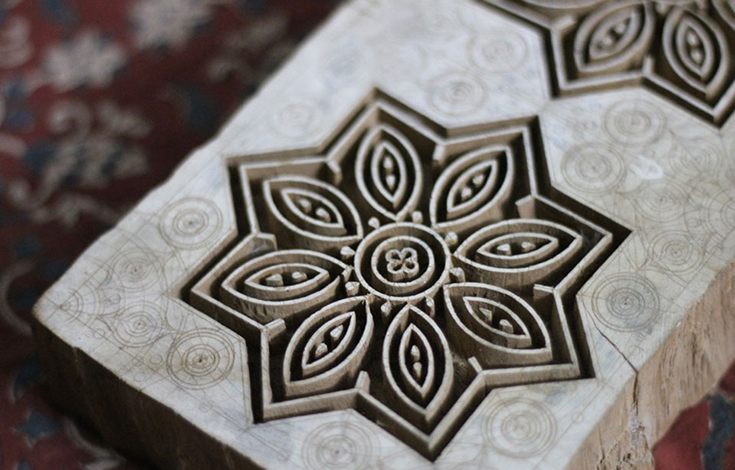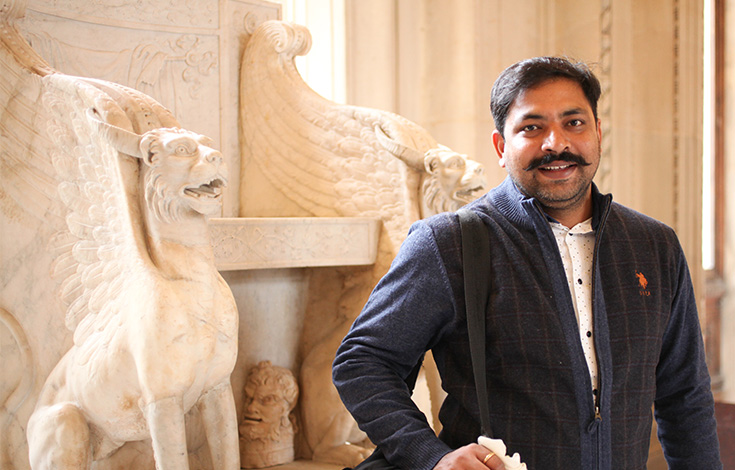The Beginning I was 17 years old when I first became interested in embroidery work. At that time, I lived with my family and we had a shop in our house for electrician work. I have two sisters and they were going to school. One day I came across some karigars sitting comfortably under a fan and working. They looked relaxed because they didn’t need to run around. I thought this would be good work for me. I didn’t know anything about the timings or the work but the facilities seemed nice. I came to know what the work was about after I started working there. When I was 20, my mother told me to go to Mumbai to find a job. I went by train alone to Mumbai and stayed with relatives. I looked around for sometime, and at one place they told me to go to companies doing embroidery and tell them that I know how to do it. When I arrived at the company they asked me how long I had been in Mumbai. I told them that this was my first time coming from Lucknow and they gave me an interview. They also gave me a swatch to work on and I did it. Then they told me to come back the next day. This was in 2002.
One day I came across some karigars sitting comfortably under a fan and working. They looked relaxed because they didn’t need to run around. I thought this would be good work for me.
Work I know two styles – ari and zardozi. Both are done by hand. Most karigars know how to do one of these styles but I learned both because at the time ari wasn’t popular. I didn’t understand why I needed to learn it when other styles were doing better in the market and I could do those instead. But the other workers in Lucknow told me that those other styles were going to stop in the future so if I knew both, there would be no tension. That’s how I learned two styles. Very few people know how to do both these styles – in our unit, there are ten or 15 who know how.
After working for three of four years, I heard that this company had opened. I heard it was good and offered conveniences. The reason I enjoy working here is because it is “duty work” – meaning the working hours are regular and not excessive. In all other places they make you work for 12 or 14 hours but here we work for 11 hours, sometimes ten. That’s why he (the boss) doesn’t have a problem getting people to work for him. Here I get recognition and knowledge, the money is good and payment is made on time. There are many people here who have worked for ten years. I have been working with Max for seven years.
…The other workers in Lucknow told me that those other styles were going to stop in the future so if I knew both, there would be no tension.
On why there are so few women karigars There are plenty of Muslim women working in Lucknow but in Mumbai, they are not interested in it. Also here, Muslim women are not allowed to work. They are not as good, the difference between women’s work is that the finishing is not as good.
On the next generation of karigars The younger generation is not interested in learning this work. Many of the karigars here are in their 30s and 40s. There are very few new, younger people joining. There are many issues – timing is one, they don’t want to work longer than eight hours a day. In our work, in most places the duty is a lot and money is less. For working extra, there is extra payment but we feel it is low. Working for 14 hours for little money is of no use. We question whether it is worth it for those three extra hours. Many karigars are leaving for these reasons. From my own friends, about 25 have left and gone elsewhere on their own – they have moved to Dubai and other places. Some have become taxi drivers. They get more money though they have to put in more effort. Here, we get to to sit for hours together.
We feel sad that karigar work might end but the responsibility lies with big people like my boss and the merchants. They should realize that if karigars are leaving this profession, why and what are their problems? If the payment is like what is offered here, that’s one thing, but if we are working for 12, 13, 14 hours and without timely payment nobody will want to continue.
My family lives in a room with me. I have one child, two years old. I want him to study; I don’t want him to do this work. You ask anybody and they will say the same thing – they don’t want their children to take up this profession. We would like them to study so they can do office work. They can begin at ten and come home by six, get a better salary and paid leave facilities so they may celebrate festivals and take holidays. We feel sad that karigar work might end but the responsibility lies with big people like my boss and the merchants. They should realize that if karigars are leaving this profession, why and what are their problems? If the payment is like what is offered here, that’s one thing, but if we are working for 12, 13, 14 hours and without timely payment nobody will want to continue.
Inspiration Our work involves a lot of imagination – our ideas depend on colors we see from photos that people bring. From there, we use our intuition to decide what will appeal to the client. We know what will be liked in Europe and Italy. The main difference we see is that some people like a matte finish and others like shine. My favourite work is sampling. I don’t like making the same thing again and again, like in production. I like to make different things.
Digital References On my phone, I use the internet – I am not that educated so I use it mainly for downloading games and songs. From the pictures I can understand some of it. I can send SMS’s also.
Note: Translated from Hindi. Photos of Gudda’s work unavailable due to employer’s client confidentiality policy.





Its an amazing art and I feel this must not vanish. As per gudda Prasad ji, its true that this art is appreciated but paid less. I know a bit of ari work and have also worked using khatli and embroidery hoops I love to embroider. But I want to learn this art in detail so that I get good finishing. I wish I could join here as a trainee.